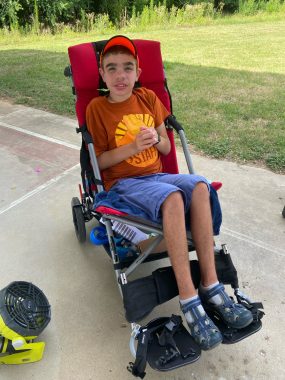As My Son With Sanfilippo Syndrome Slows Down, Time Speeds Up

“Will’s just doing so well,” a well-intentioned person gushes to me. I smile, happy for the attention and recognition Will receives for his hard work. “I just see him up and walking so much more,” the person continues. “You can really tell he’s getting better!”
I maintain my smile and politely thank the speaker before excusing myself. I take a deep breath and internally sigh. Children with Sanfilippo syndrome do not get better. It’s a progressive, terminal condition with no treatment or cure. What the person is praising is actually part of the toll of the disease.
Very few people see Will daily, and even fewer people understand the reality of living day to day with Sanfilippo. In 2017, we had to purchase an adaptive stroller for Will because he had outgrown traditional stroller options. We paid out of pocket; our insurance at that time wouldn’t cover the stroller because Will was still “mobile within the home” (possibly the worst standard for coverage of a mobility aid, but I digress).
At the time, our desperate need for the stroller wasn’t dictated by his difficulty walking (although walking distances in the Texas heat was always a concern), but by a need for safety.
Will had to be watched constantly. He couldn’t be left unattended. He had no sense of safety and would dart out in a front of a car or put his hand on a hot stove with zero hesitation. Sanfilippo is characterized by extreme hyperactivity, especially in the early years, and it was both terrifying and exhausting.
Holding on to Will and keeping him safe was difficult, especially while also caring for his baby sister. He was strong and would pull and flail to get away when something caught his attention. Cognitively, there was no teaching him to listen and stay put; his brain literally could not comprehend the instruction. Strapping him into a stroller was one of the few ways to ensure he was safe so I could attend to Little Sister, answer a phone call, cook dinner, or even go to the bathroom.

A typical day at home with Will during the early years of his Sanfilippo diagnosis was chaotic. (Photo by Valerie Tharp Byers)
Purchasing the adaptive stroller was both emotionally difficult (it was our first piece of medical equipment) and freeing. With it, Will was now able to stay in child care at my gym, meaning I could exercise while the workers read books and sang songs with him, safely stationary.
We could also do summer camps, with me as his aide, because I could more easily keep him focused on the camp activities instead of him constantly eloping after something that interested him. My husband and I worked hard to give Will the proper amount of exercise out of the chair to maintain muscles while acknowledging that having a safe place to seat him allowed Will more access to socialization and experiences.

Will in 2017, with his first adaptive stroller. (Photo by Valerie Tharp Byers)
However, that meant a lot of people only got to know Will in a chair, and in our society, people often equate chair use with a complete loss of mobility, as they lack awareness of the nuances of mobility aids and support devices.
Will turned 12 last month. Although individual expression of the progression of Sanfilippo varies, we do know the statistics, and we see the changes. Will is slowing down. He’s not constantly trying to elope, which means he can walk around more and sit in regular chairs without needing to be strapped in. While still requiring high levels of supervision, he will now rest on the couch and watch PBS Kids without running around, pulling down toys, and trying to climb shelves every five seconds.
Right now, he’s watching an episode of “Molly of Denali” while I type this at 10 a.m. on a weekday, a situation I would’ve thought impossible just two years ago, when my work time was relegated to 11 p.m. after he was asleep.

Will, in 2022, now uses his adaptive stroller more for rest than safety needs. (Photo by Valerie Tharp Byers)
He’s changing. And while it may seem like life is getting easier because his behaviors are now less unpredictable, it’s also frightening seeing our ball of constant energy begin to burn out. We know our time is limited. Each moment he slows down reminds us that we are headed toward the inevitable that Sanfilippo brings every child.
So yes, he’s sitting more quietly at camps. And yes, he’s walking around more now. But it’s not because he’s getting better (and I’ll save the commentary on how being still, quiet, and controlled are ableist expectations for a future column). It’s because his body, every day, succumbs a bit more to Sanfilippo.
And although we hold no ill will toward the people who make the comments because they truly do care about our son, it’s difficult to hear praise when we know the truth: the “easier” it becomes to take care of Will, the closer we come to the heartbreak of losing him.
Note: Sanfilippo News is strictly a news and information website about the syndrome. It does not provide medical advice, diagnosis, or treatment. This content is not intended to be a substitute for professional medical advice, diagnosis, or treatment. Always seek the advice of your physician or other qualified health provider with any questions you may have regarding a medical condition. Never disregard professional medical advice or delay in seeking it because of something you have read on this website. The opinions expressed in this column are not those of Sanfilippo News or its parent company, Bionews, and are intended to spark discussion about issues pertaining to Sanfilippo syndrome.








Leave a comment
Fill in the required fields to post. Your email address will not be published.